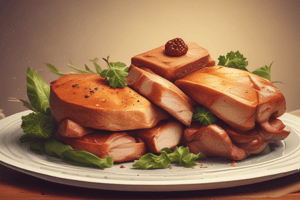Podcast
Questions and Answers
What is the primary purpose of a cold meat fork?
What is the primary purpose of a cold meat fork?
- To clean up spills on the plate
- To serve hot soups
- To serve cold meats and cheeses (correct)
- To decorate plates with garnishes
What is the typical diameter of a soup plate?
What is the typical diameter of a soup plate?
- 9 to 10 inches (correct)
- 7 to 8 inches
- 5 to 6 inches
- 11 to 12 inches
According to the general principle, what portion of the plate should be left empty when plating food?
According to the general principle, what portion of the plate should be left empty when plating food?
- One-third (correct)
- Two-thirds
- One-half
- One-quarter
What should be done immediately if sauces or food spills onto the plate?
What should be done immediately if sauces or food spills onto the plate?
When decorating a plate, what is the primary role of the plate itself?
When decorating a plate, what is the primary role of the plate itself?
Which of the following is a good way to create varied textures on a plate?
Which of the following is a good way to create varied textures on a plate?
What are some suitable display bases for small appetizers, according to the text?
What are some suitable display bases for small appetizers, according to the text?
What is a good reason to use garnishes on a plate?
What is a good reason to use garnishes on a plate?
Flashcards
What is a Cold Meat Fork?
What is a Cold Meat Fork?
A utensil used for serving cold cuts and cheeses. It has a wide rim (1-2 inches) and a well (6-7 inches across).
What is a Soup Plate?
What is a Soup Plate?
A wide, shallow bowl with a flanged rim, typically measuring 9 to 10 inches in diameter. It is specifically designed for serving soups.
What is Plating?
What is Plating?
Arranging food on a plate before serving guests, aiming for a visually appealing and balanced presentation.
What are the principles of Plating?
What are the principles of Plating?
Signup and view all the flashcards
Explain plate decoration.
Explain plate decoration.
Signup and view all the flashcards
What is Garnishing?
What is Garnishing?
Signup and view all the flashcards
How are appetizers presented?
How are appetizers presented?
Signup and view all the flashcards
How important is temperature when serving food?
How important is temperature when serving food?
Signup and view all the flashcards
Study Notes
Cold Meat Fork
- Essential for serving cold cuts and cheeses
- Plate rim: 1-2 inches wide
- Plate depth: 1½ inches
- Plate well: 6-7 inches across
Soup Plate
- Wide, shallow bowl
- Flanged rim
- Diameter: 9-10 inches
Plating/Presenting Poultry Dishes
- Arrange food on individual plates immediately before serving
- Leave approximately one-third of the plate empty
- Balance food on the plate with enough for hospitality but not overcrowding
- Check food temperature before presenting to guest
- Clean spills or sauces with a moistened sponge or cloth
Decorating the Plate
- Plate is a frame for the food
- Use various shapes and colors
- Add colorful spices, seasonings, or sugars
- Consider Hawaiian or Himalayan salts
- For appetizers:
- Use small herbs/noodles/sprigs
- Decorate for visual appeal
- Ensure food is heated if necessary
Combining Shapes, Colors, and Textures
- Combine foods with diverse shapes, colors, and textures
- Odd numbers of dishes are better than even
- Mix different colors and shapes (e.g., filet mignon with potatoes and asparagus)
- Avoid nearly identical items (e.g., risotto and rice)
- Stack components for visual interest (e.g., side dishes or dishes on display)
Garnishing
- Enhance the appearance by adding elements
- Use items relevant to herbs or spices used in preparation
- Fresh herbs, wedges of citrus, or small fruit slices
- Items like cucumber, pineapple, avocado, or apple can be arranged in an arc
Studying That Suits You
Use AI to generate personalized quizzes and flashcards to suit your learning preferences.





